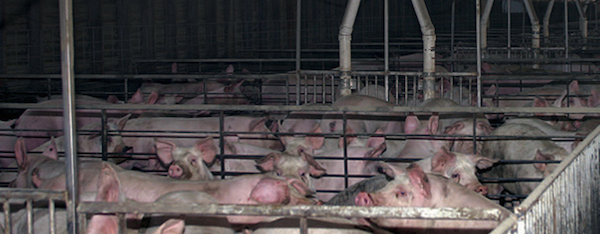The book CAFO - The Tragedy of Industrial Agricultural Factories, sits in my basement bookshelf, in a place where I'm confident my kids won't notice it. It's not that the book is gruesome; a book on the subject of concentrated animal feeding operations (CAFOs) could easily have been more bloody. And it's not that my kids don't know the difference between "happy meat" and Happy Meals. Maybe it's simply the fact that the terrific book CAFO -- all 300 gigantic, photo-filled pages of it -- shows a side of human nature that I'm still trying to protect my elementary schoolers from. A side that I, like many others, would prefer to keep in the basement -- just out of reach of children.
CAFO, meticulously crafted by Daniel Imhoff, Douglas Tompkins, and Roberto Carra, is an important book, with sections describing not just animal confinement, but also antibiotic drug abuse, regulations, technology, deforestration, and pollution. As I read it, paging through its striking images of animals in feedlots, lined up, confined, and turned into sandwich meat, I was struck by how far the reality of our food system is from the stories we learned when we were kids.
 Old MacDonald had a farm
Old MacDonald had a farm
Ee-i-ee-i-o
And on his farm he had a chicken
Ee-i-ee-i-o
Somehow, the photos that fill the book CAFO look like pictures of an alternative universe, one where the Old MacDonald story we learned as kids went very, very wrong.
Old MacDonald had thousands of chickens in this tiny little space
Ee-i-ee-i-o
Of course, this bizarro, "alternate" world is the one we live in. Here's what it says on the CAFO website:
In the United States and other parts of the world, livestock production is becoming increasingly dominated by concentrated animal feeding operations (CAFOs). In a CAFO, animals are crammed by the thousands or tens of thousands, often unable to breathe fresh air, see the light of day, walk outside, peck at a plants or insects, scratch the earth, or eat a blade of grass.
Over 50 billion food animals are raised and slaughtered every year (not including massive quantities of farmed fish). Grazing and growing feed for livestock now occupy 70 percent of all agricultural land and 30 percent of the ice-free terrestrial surface of the planet. If present trends continue, meat production is predicted to double between the turn of the 21st century and 2050. Yet already, the Earth is being overwhelmed by food animals that consume massive quantities of energy and resources, whose wastes foul waterways and farmlands, and when eaten excessively, degrade our health.
CAFO: The Tragedy of Industrial Animal Factories is a powerful indictment of modern food production. But as the book shows, it doesn't have to be this way. Ultimately, CAFO offers a compelling vision for a healthier food system: one that is humane, sound for farmers and communities, and safer for consumers and the environment.
I can't call the contents of CAFO beautiful, but the book itself is impressive -- graphically rich, very compelling, and engagingly written. Along with it's companion book, The CAFO Reader -- a collection of essays by Michael Pollan, Eric Schlosser, Wendell Berry, Fred Kirschenmann, and others -- it offers a well researched, accessible, harrowing look at our food industry.

Lee Zukor is the founder of Simple, Good, and Tasty. Email him at lee@simplegoodandtasty.com.




